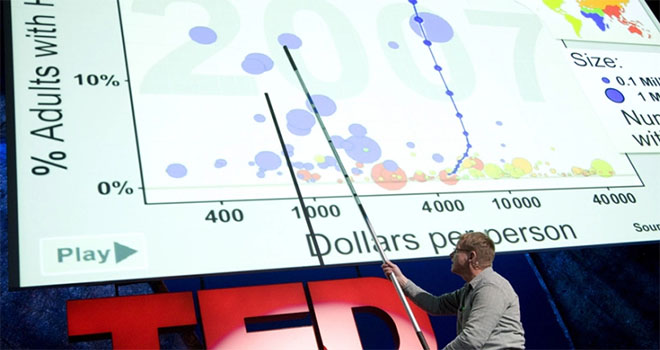Why and How to Bring Statistics Into Your Speech
November 24, 2017 - Dom Barnard
Using statistics in public speaking is a powerful way to add a quantifiable and persuasive aspect to your message. It provides a basis on which you can build an argument, prove a statement, or support an idea.
The key to using statistics is being able to extract meaning and patterns from data in a way that your audience can understand.
In this article, we’ll explain why statistics are important, how to choose the right statistic and how to integrate it into your presentation for maximum impact.
Why use statistics in your speech?
It can be very time consuming finding the right statistic to include in your presentation. Added to this is the possibility that an audience member questions whether the data is reliable. However, statistics can add a range of benefits to your presentation:
- Add realism to your presentation – numbers and data are a good way to ground your presentation and being reality to your presentation. For example, stating that ‘wearing a seatbelt could save your life in a crash at 60mph’, is not as impactful as ‘you have a 20% chance of surviving a 60mph crash if you don’t wear a seatbelt’.
- Increase your credibility - using a statistic shows that you’ve done research and are knowledgeable about the subject matter. Also, if you use a statistics from a trusted source (e.g. the NHS), it will boost your credibility.
- Make your presentation memorable – interesting statistics will stay with your audience long after the presentation finishes.
- Emotionally impact your audience – you can increase the emotional impact to your audience by including relevant, usually shocking, statistics, for example ‘in sub-Saharan Africa, almost 60% of youth between the ages of about 15 and 17 are not in school.’

Hans Rosling using statistics in his TED talk - 'Insights on HIV, in stunning data visuals'.
How do you choose the right statistic?
After you’ve decided to use statistics in your presentation, you need to find the right one for the message you’re delivering. It’s easy to get lost in the huge number of statistics out there, not all of them accurate. With so much data, how do you decide which statistic to use?
Here are several factors to consider when making your choice of statistic:
- Make it surprising - your aim is to have your audience members leave the presentation and say to their friends, ‘Let me tell you about this interesting statistic I heard…’
- Leave the greatest impact on your audience - you’ll need to do some audience analysis for this one. Once you have found the demographic or interested of your audience, you’ll be able to find a relevant statistic.
- Validate your message or argument – be careful not to include statistics just because they are interesting. They must be closely tied to your message or supporting points. If it isn’t relevant to your speech, your audience may remember the statistic, but they won’t remember you or your message.
Where do these statistics come from?
Statistics can come from a number of sources, here are some common ones:
- Presenting findings from research by understanding which results are meaningful and significant in the context of your presentation.
- Results from a survey and discussion of key findings, such as the average and extremes of that survey.
- Comparisons of data and benchmarking results along with competitive data and public data.
- Social media surveys with your existing audience. You can easily set these up on Twitter and Facebook.
Watch this TED talk on 3 ways to spot a bad statistic.
Weaving the statistic into your speech
It’s important to provide context for your statistic. Just adding a statistic on its own, no matter how interesting, will not have the desired effect.
For example, if I told you Snapchat has 170 million daily users, you might think that is a huge number for a social app. However, if I also told you Facebook has 1.37 billion daily users, this allows you to interpret the statistic in a more meaningful context.
Here are some tips for bringing your statistic into your speech:
- Compare how the statistic changes over time. The most powerful aspect may be to see how the value has changed from one week to the next, or from one year to the next.
- Bring your statistic to life by telling the story of one of the numbers. For example, if your statistic is about the number of billionaires in the world, you might begin by telling the story of Mark Cuban, and then reveal that he is only one of over 2,000 such billionaires.
- Don’t rely on your audience understand how the statistic is relevant. Explain the connection between the statistic and your message. A direct approach is usually best, such as ‘This is important because…’

Delivering the statistic for maximum impact
So you’ve found the right statistic, added it to your speech in an effective way, now you need to deliver that statistic for maximum impact.
Here are some techniques you can use to increase:
- Speak slower than your normal rate - this will signal the importance of the statistic and allow you to clearly articulate your words. Read this on how to slow down your talking.
- Use body language to demonstrate the magnitude - standing with your arms wide open, for example, creates a sense of size.
- Pause immediately before the statistic – this helps create suspense.
- Pause immediately after the statistic - to give your audience time to process the meaning.
- Use facial expressions - to convey the appropriate reaction. (i.e. show your own shock, surprise, sadness, etc.)
- Hint at its importance - you can do this earlier in the speech to build suspense (e.g. ‘In the first section of the presentation, I’m going to reveal a statistic that will change the way you view politics) or use a quicker approach (e.g. ‘If you remember one thing from this speech, remember this…’)
- Add a slide with the statistic highlighted - if you are speaking with slides, you might show a slide that links with your statistic. You could use a chart to highlight the magnitude of the number, or you could use a photograph to strike a more emotional tone.
Helping your audience understand the statistic
- Use statistics that are easily understood. Many people understand what an average is but not many people will know more complex ideas such as variation and standard deviation.
- Use reputable sources for the statistics you present in your speech, such as government websites, academic institutions and reputable research organizations and research think tanks.
- Many people try and avoid statistics, so when presenting data explain the context and use visual aids if possible.
- When presenting graphs, make sure that the key points are highlighted, the graphs are not misleading and the axes are clearly labelled
Examples of great statistics in presentations
Here are some statistics which, if used in the right context, would leave an impact with your audience and make your presentation more memorable.
- Stat #1 – Google gets over 100 billion searches a month [source]
- Stat #2 – B2B companies that blogged 11+ times per month had almost 3X more traffic than those blogging 0-1 times per month [source]
- Stat #3 – There are more people alive today than have ever died [source]
- Stat #4 – 72% of adult internet users use Facebook [source]
- Stat #5 – 91% of people say ads are more intrusive today than two years ago. [source]
- Stat #6 – In a room of just 23 people there is a 50% probability of two people having the same birthday. [source]
- Stat #7 – There are more possible iterations of a game of chess than there are atoms in the known universe [source]

